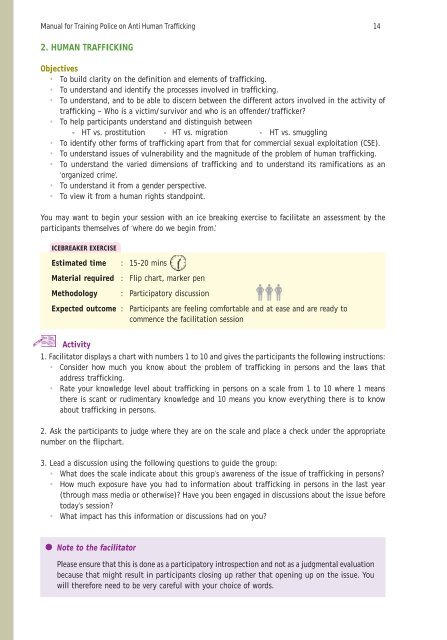Manual for Training Police on Anti Human Trafficking
Manual for Training Police on Anti Human Trafficking
Manual for Training Police on Anti Human Trafficking
Create successful ePaper yourself
Turn your PDF publications into a flip-book with our unique Google optimized e-Paper software.
<str<strong>on</strong>g>Manual</str<strong>on</strong>g> <str<strong>on</strong>g>for</str<strong>on</strong>g> <str<strong>on</strong>g>Training</str<strong>on</strong>g> <str<strong>on</strong>g>Police</str<strong>on</strong>g> <strong>on</strong> <strong>Anti</strong> <strong>Human</strong> <strong>Trafficking</strong> 14<br />
2. HUMAN TRAFFICKING<br />
Objectives<br />
To build clarity <strong>on</strong> the definiti<strong>on</strong> and elements of trafficking.<br />
To understand and identify the processes involved in trafficking.<br />
To understand, and to be able to discern between the different actors involved in the activity of<br />
trafficking – Who is a victim/survivor and who is an offender/trafficker?<br />
To help participants understand and distinguish between<br />
- HT vs. prostituti<strong>on</strong> - HT vs. migrati<strong>on</strong> - HT vs. smuggling<br />
To identify other <str<strong>on</strong>g>for</str<strong>on</strong>g>ms of trafficking apart from that <str<strong>on</strong>g>for</str<strong>on</strong>g> commercial sexual exploitati<strong>on</strong> (CSE).<br />
To understand issues of vulnerability and the magnitude of the problem of human trafficking.<br />
To understand the varied dimensi<strong>on</strong>s of trafficking and to understand its ramificati<strong>on</strong>s as an<br />
‘organized crime’.<br />
To understand it from a gender perspective.<br />
To view it from a human rights standpoint.<br />
You may want to begin your sessi<strong>on</strong> with an ice breaking exercise to facilitate an assessment by the<br />
participants themselves of ‘where do we begin from.’<br />
ICEBREAKER EXERCISE<br />
Estimated time : 15-20 mins<br />
Material required : Flip chart, marker pen<br />
Methodology : Participatory discussi<strong>on</strong><br />
Expected outcome : Participants are feeling com<str<strong>on</strong>g>for</str<strong>on</strong>g>table and at ease and are ready to<br />
commence the facilitati<strong>on</strong> sessi<strong>on</strong><br />
Activity<br />
1. Facilitator displays a chart with numbers 1 to 10 and gives the participants the following instructi<strong>on</strong>s:<br />
C<strong>on</strong>sider how much you know about the problem of trafficking in pers<strong>on</strong>s and the laws that<br />
address trafficking.<br />
Rate your knowledge level about trafficking in pers<strong>on</strong>s <strong>on</strong> a scale from 1 to 10 where 1 means<br />
there is scant or rudimentary knowledge and 10 means you know everything there is to know<br />
about trafficking in pers<strong>on</strong>s.<br />
2. Ask the participants to judge where they are <strong>on</strong> the scale and place a check under the appropriate<br />
number <strong>on</strong> the flipchart.<br />
3. Lead a discussi<strong>on</strong> using the following questi<strong>on</strong>s to guide the group:<br />
What does the scale indicate about this group’s awareness of the issue of trafficking in pers<strong>on</strong>s?<br />
How much exposure have you had to in<str<strong>on</strong>g>for</str<strong>on</strong>g>mati<strong>on</strong> about trafficking in pers<strong>on</strong>s in the last year<br />
(through mass media or otherwise)? Have you been engaged in discussi<strong>on</strong>s about the issue be<str<strong>on</strong>g>for</str<strong>on</strong>g>e<br />
today’s sessi<strong>on</strong>?<br />
What impact has this in<str<strong>on</strong>g>for</str<strong>on</strong>g>mati<strong>on</strong> or discussi<strong>on</strong>s had <strong>on</strong> you?<br />
Note to the facilitator<br />
Please ensure that this is d<strong>on</strong>e as a participatory introspecti<strong>on</strong> and not as a judgmental evaluati<strong>on</strong><br />
because that might result in participants closing up rather that opening up <strong>on</strong> the issue. You<br />
will there<str<strong>on</strong>g>for</str<strong>on</strong>g>e need to be very careful with your choice of words.

















